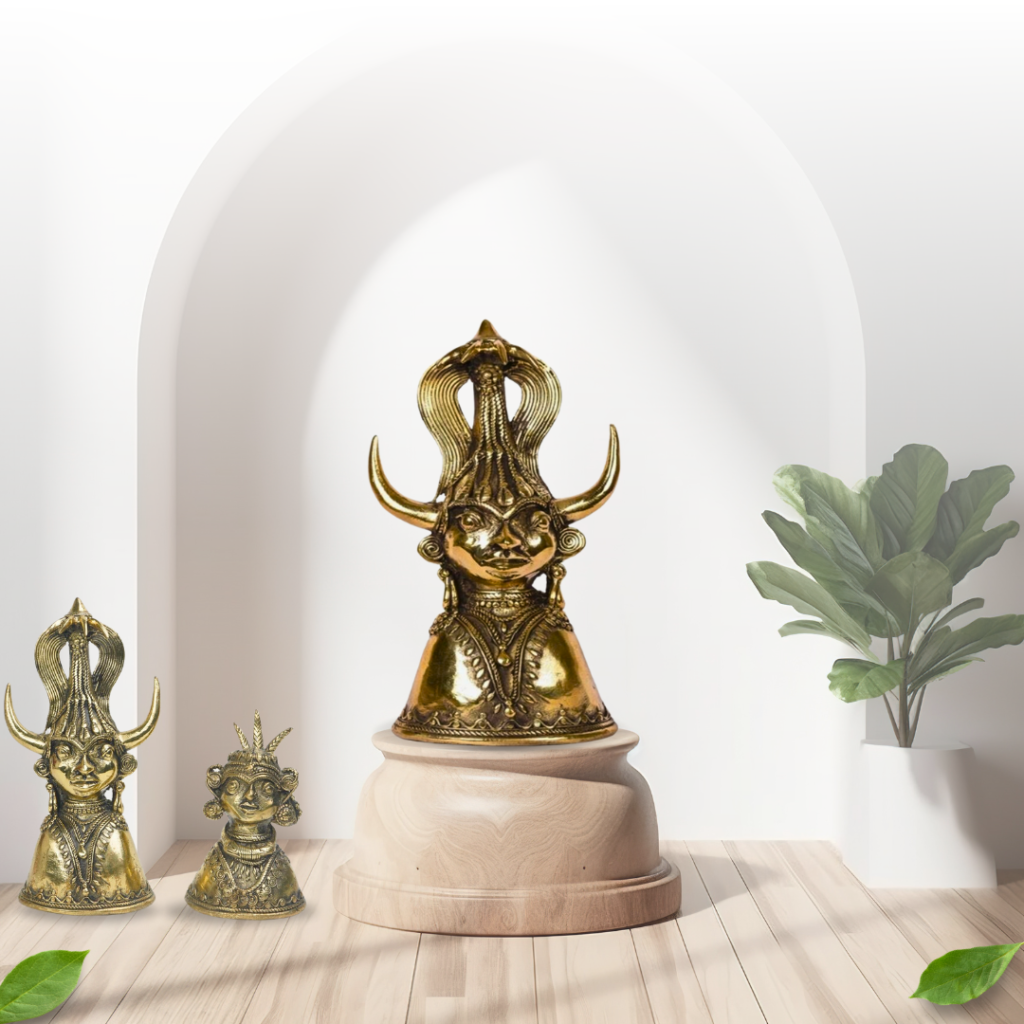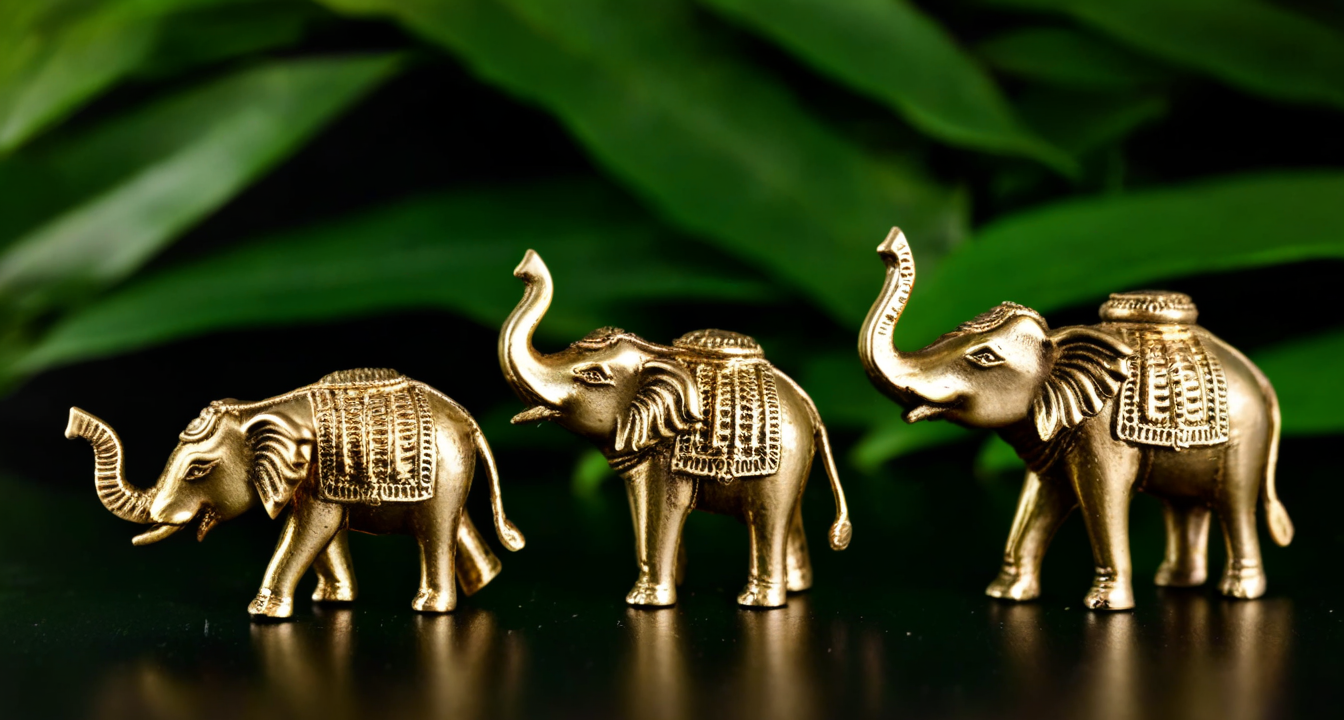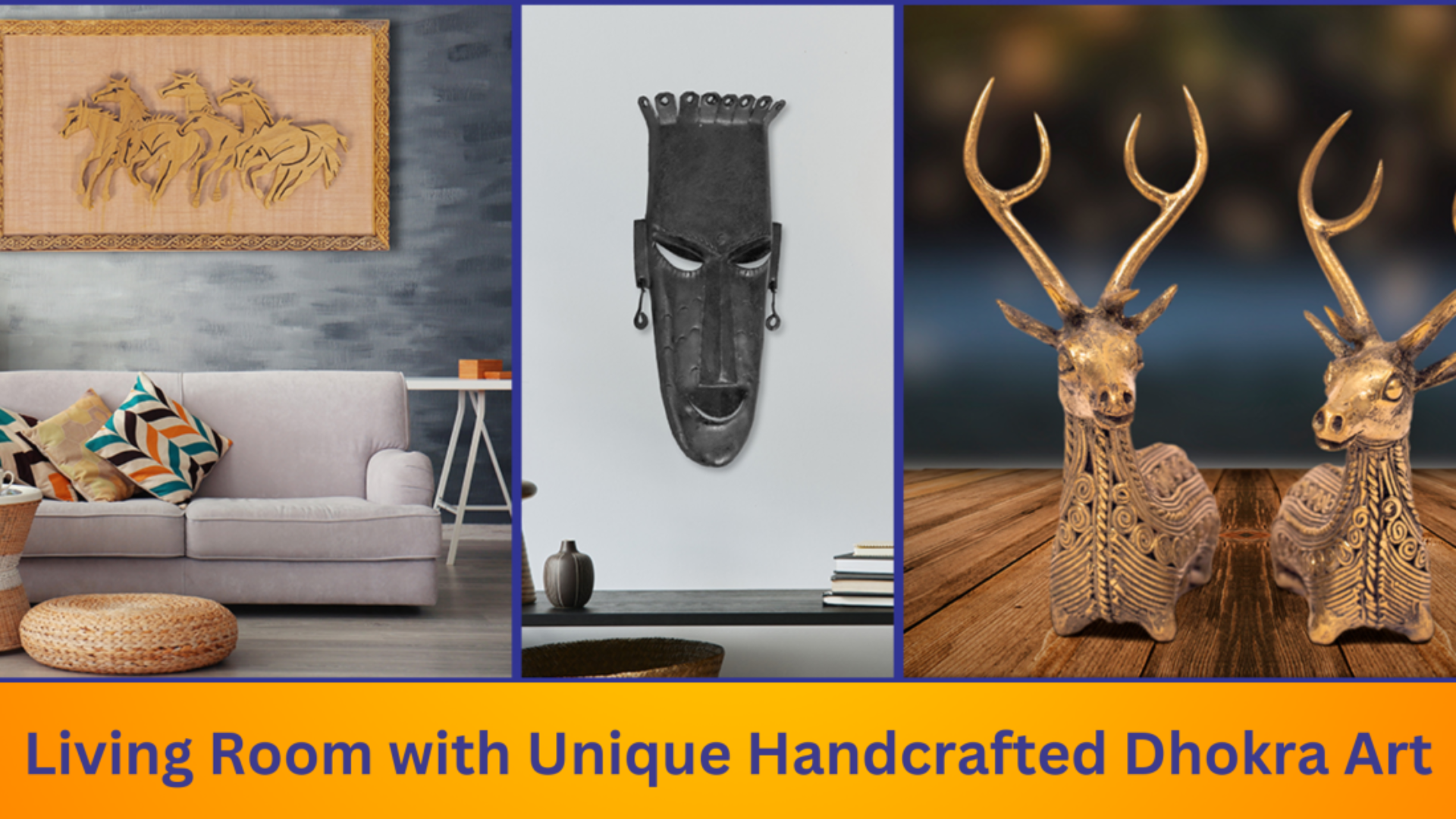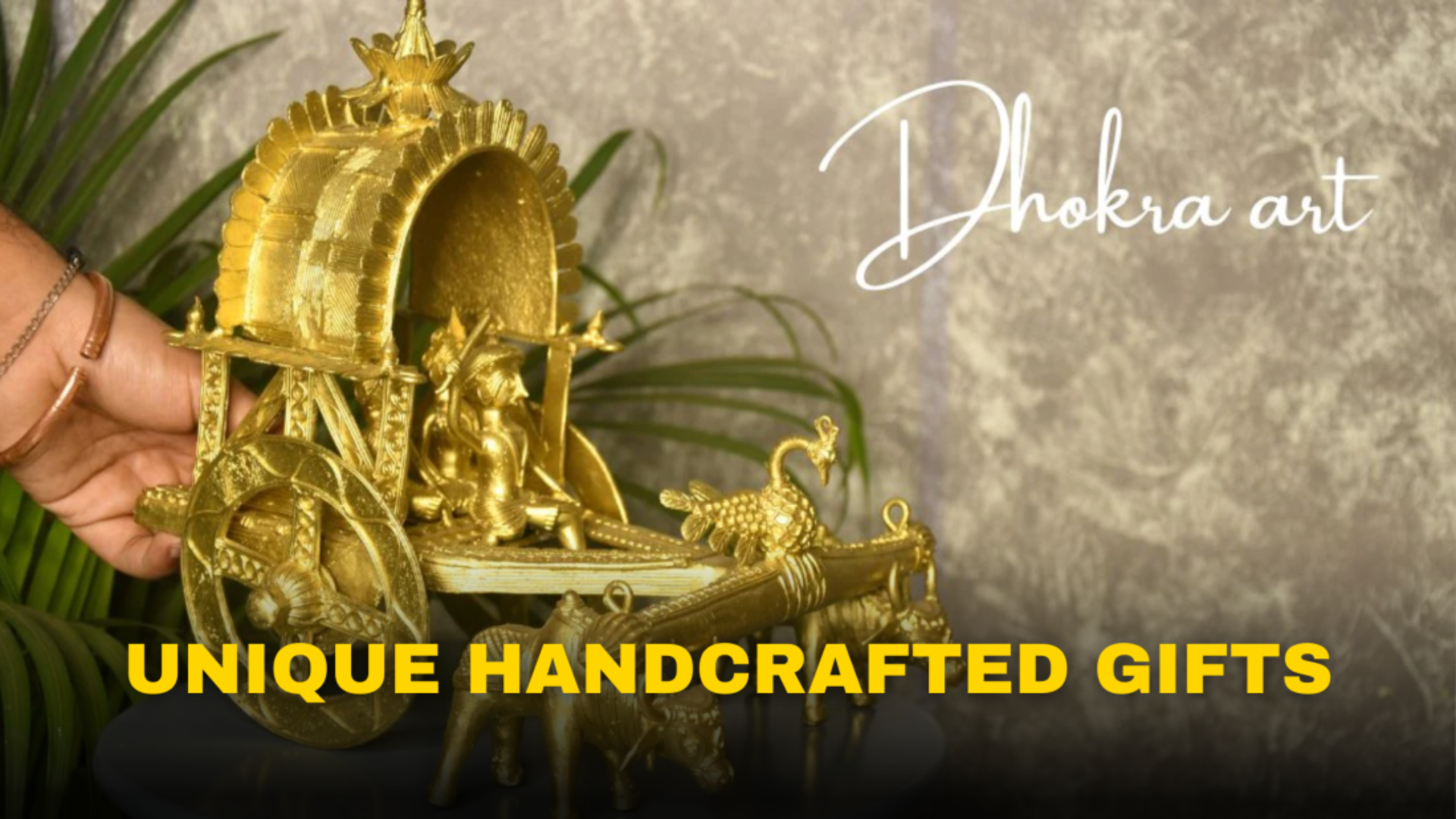India has a long history of arts and crafts, with each region adding its own distinctive contribution. One area that stands out is Bastar in Chhattisgarh. The tribal communities of Bastar have gained worldwide attention for their outstanding craft work, which includes woodwork, bamboo art, soil art, and metal arts. Among these creative expressions, Dhokra art has become a significant aspect of India’s cultural heritage. This art form has been practiced not only in Bastar but also in West Bengal, Odisha, Andhra Pradesh, and Telangana. The Dhokra technique has even secured Geographical Indication (GI) tags in some regions, which shows how highly regarded and unique it is.
Towards the end, we will include a brief section on Artline Creation, which is known as India’s best seller for Dhokra Art, Bastar Art, Wall Paintings, and more. We will also answer five frequently asked questions to help you learn more about these crafts.
Table of Contents
1. An Overview of Bastar’s Tribal Communities and Their Crafts
Bastar is located in the southern part of Chhattisgarh and is home to various Adivasi (indigenous) communities. These tribal groups have preserved their ways of life for centuries, continuing their customs, music, dance, and craft forms. Their craft traditions are influenced by the resources available in the natural environment, which includes forests, rivers, and hills. This connection to nature can be seen in the materials and methods they use.

1.1 Varied Art Forms in Bastar
Bastar is well-known for multiple forms of art. Here are some of the most recognized ones:
- Woodwork: The tribal groups carve wood into masks, sculptures, household items, and decorative pieces. Traditional beliefs and local tales often inspire the designs.
- Bamboo Art: Baskets, mats, and other household products are woven using thin bamboo strips. This craft requires a high level of skill and attention to detail.
- Soil Art: Terracotta and other types of clay are molded into items like pots, utensils, and decorative figures. These clay works often show local myths or stories related to everyday tribal life.
- Metal Arts: Dhokra art is the most famous metal art form in Bastar, alongside wrought iron crafts. Artisans use a range of metals, most commonly brass, bronze, and recycled iron, to create sculptures and figurines.
2. What is Dhokra Art?
Dhokra is a form of metal casting that has been practiced in India for about 4,000 years. One of the earliest known artifacts using this lost wax technique is the “Dancing Girl” figurine from Mohenjo-daro, an ancient city of the Indus Valley Civilization.
The name “Dhokra” originally comes from the Dhokra Damar tribes of West Bengal, who have been known for their metalwork for many generations. Today, Dhokra art is not limited to any single community or region. It is practiced across different parts of India, including Chhattisgarh, West Bengal, Odisha, Andhra Pradesh, and Telangana. The unifying factor is the distinctive hollow casting and lost wax method that gives Dhokra its characteristic look.
2.1 Recognized by Geographical Indication (GI) Tags
In certain parts of India, Dhokra crafts have received Geographical Indication tags. A GI tag is a type of intellectual property right that indicates a product is from a specific place. It protects the craft from imitations and highlights the unique characteristics connected to the region.
GI tags also draw attention to the skill and dedication of the artisans. This labeling helps consumers identify genuine handcrafted Dhokra pieces, ensuring that the money they pay goes to support local artisans and maintain the tradition.
3. The Ghadwas of Bastar and the Jharas of Raigarh
In Chhattisgarh, two groups in particular are closely tied to Dhokra art:
- The Ghadwas of Bastar: The term “Ghadwa” is said to come from the word “Ghalna,” which means “to melt.” The Ghadwa community primarily works with bell metal (an alloy of copper, tin, and sometimes other metals) and produces intricate Dhokra items. They are masters at using the lost wax method to craft sculptures of deities, tribal musicians, and a variety of ornaments.
- The Jharas of Raigarh: This group has also been part of a long tradition of working with metals. They are known for creating Dhokra items using a similar set of tools and processes. These items often reflect themes of rural life, musical traditions, and local beliefs.
Both groups pass their knowledge from one generation to the next. The workshops are often set up in community spaces or near the artisans’ homes, where family members learn the craft by watching and practicing from a young age.
4. Significance of Dhokra Art in Tribal and Modern Life
Dhokra art serves more than just a decorative purpose. In tribal communities, these metal crafts have cultural and social importance. Sculptures of deities and symbols play a role in rituals and festivals. Metal figurines depicting animals, humans, and natural motifs are often placed in homes for good luck or to remind people of their ties to the land.
In modern times, Dhokra items have become popular as collectibles or for interior design. The timeless appeal of these handcrafted objects, combined with their ethnic charm, has made them sought after in urban markets. Many people buy Dhokra pieces to support the artisans or to add a unique touch to their living and working spaces. The method itself, being environmentally friendly and based on local resources, also aligns with the growing interest in sustainable and handmade products.
5. The Lost Wax Technique: Ancient yet Modern
The Dhokra art tradition relies on a process known as the lost wax technique. Although it has been around for thousands of years, it continues to be used because it allows artisans to create detailed and unique pieces. Here is a more detailed breakdown of the steps:
- Preparation of the Clay Core:
The first step involves shaping a clay core that roughly matches the final design. This clay core is dried in the sun until it becomes sturdy.- Artisans often gather clay from riverbanks or areas with fine soil.
- The clay is sometimes mixed with other organic materials to improve its texture and strength.
- Application of Wax over the Clay Core:
A layer of wax is applied on top of the clay model. This wax is usually made from a mixture of:- Pure beeswax
- Resin from the Damara Orientalis tree
- Nut oil (commonly sourced from seeds found in the region)
- Adding Another Layer of Clay:
Once the wax design is finished, artisans cover it with a second layer of clay. This outer layer forms a hardened shell when dried.- When the clay shell is properly heated or baked, the wax in between the two clay layers melts away, leaving a hollow space that matches the intricate details of the wax model.
- Melting and Pouring the Metal:
In traditional Dhokra art, metals like brass or bronze are heated until they melt. This molten metal is then carefully poured into the hollow space left by the wax.- Temperature control is crucial because too much heat can damage the outer clay shell, while too little heat can affect the flow of the molten metal.
- Cooling and Final Touches:
After the molten metal is poured, the entire mold is set aside to cool. Once cooled, the clay shell is broken off, revealing the rough metal figure inside.- The figure is then polished, and any extra metal bits are removed. Fine detailing, like smoothing and cleaning certain areas, gives the final product its shine and character.
5.1 Recycled Iron in Dhokra-Related Crafts
Apart from brass and bronze, some artisans also work with recycled iron or wrought iron. The use of recycled metal is cost-effective and aligns well with eco-friendly practices. Often, these iron pieces are shaped into simpler forms, such as lamps, candle stands, or abstract shapes representing people or animals. By integrating iron elements into their creations, artisans expand the variety of items they offer to buyers.
6. Cultural and Historical Background
6.1 Connection to the Indus Valley Civilization
Archaeological finds show that metal casting in India is at least 4,000 years old. The famous “Dancing Girl” figurine of Mohenjo-daro is one example that has captured the attention of historians and art lovers. The lost wax technique used then is essentially the same one used by today’s Dhokra artisans.
This strong link to ancient civilization is part of what makes Dhokra art so special. It reminds us of India’s long legacy in crafts and the ways in which old methods can still thrive when passed down through generations.
6.2 Local Myths and Symbolism
In Bastar, many of the designs in Dhokra art come from local stories, religious beliefs, and everyday life. Figures of tribal musicians with traditional drums, mother-and-child motifs, or animals like elephants and horses are popular themes. These symbols often carry messages of protection, fertility, or community.
When a person buys a Dhokra piece, they often bring home a fragment of that cultural story. This adds a layer of emotional value to the product, making it more than just a decorative item.
7. Challenges and Opportunities for Dhokra Artisans
7.1 Economic Pressures
Despite the global interest in Dhokra art, many artisans face financial challenges. The cost of raw materials, especially metals, can be high. Middlemen sometimes exploit the artisans by buying the finished items at very low prices and selling them at much higher rates in bigger markets.
7.2 The Importance of Fair Pricing
To keep the craft alive, it is crucial that artisans receive fair prices for their work. Governments, NGOs, and private initiatives are trying to ensure that craftspeople have direct access to markets. Online platforms and exhibitions help artisans reach a broader audience, avoiding dependency on middlemen.
7.3 Technological Improvements and Training
Although the lost wax method remains mostly traditional, some modern techniques can help increase efficiency. For example, more reliable furnaces, better temperature control, and improved tools for carving can make the process smoother without compromising the handmade touch.
At the same time, training programs and workshops can help the younger generation adapt to changing market conditions. Workshops that focus on design trends, digital marketing, and quality control help artisans keep their craft relevant to both Indian and international buyers.
8. The Role of Dhokra Art in Modern Interior Design
Dhokra sculptures and decorative pieces are popular among people looking to add a tribal or earthy feel to their interiors. The raw look of the metal, combined with detailed patterns, can fit well in both traditional Indian homes and more modern, minimalist spaces.
- Home Decor: Small figurines placed on a bookshelf or corner table can highlight the warmth of a living room.
- Offices and Public Spaces: Companies sometimes choose to display larger Dhokra items in lobbies or hallways, giving visitors a glimpse into India’s artistic heritage.
- Gifts and Souvenirs: Dhokra art can be used as gifts for weddings, festivals, or corporate events. Offering a handcrafted piece can make the occasion more memorable.
9. Preserving Tradition and Promoting Ethical Craft
9.1 Artline Creation: Supporting Artisan Communities
In recent years, many organizations have been working towards protecting traditional crafts like Dhokra. Artline Creation has gained recognition as one of India’s best sellers for Dhokra Art, Bastar Art, Wall Paintings, and other indigenous crafts. By building partnerships with artisans, Artline Creation ensures that the products maintain their originality, and the creators receive fair compensation for their hard work.
Whether you are looking for a small decorative piece to keep at home or a larger installation for a commercial space, Artline Creation offers a wide range of options that reflect India’s rich craftsmanship. They provide detailed information about each piece, which can help buyers make informed decisions.
9.2 Ways to Support Tribal Crafts
If you are interested in supporting tribal crafts and ensuring these skills survive for future generations, here are a few suggestions:
- Buy Directly from Artisans or Trusted Platforms: This step ensures fair wages and empowers artisans to continue their craft.
- Spread Awareness: Talk about Dhokra art in your social circles, share details about the process, and highlight how old and unique it is.
- Attend Exhibitions and Craft Fairs: Many cities host craft fairs where artisans come to sell their items. By attending, you can learn about different regional variations of Dhokra art.
- Gift Dhokra Products: For festivals, weddings, birthdays, or corporate events, consider giving handcrafted items. This not only supports the artisans but also introduces recipients to tribal art forms.
10. Additional Insights into the Process
10.1 Patination and Finishing
Some artisans choose to apply a patina to the finished metal item. This involves exposing the metal to various chemicals or natural elements to give it a greenish or brownish coating. Patina can provide an antique look and is often done for decorative reasons. However, many buyers also appreciate the simple metallic finish that highlights the manual effort behind the piece.
10.2 Creative Variations
In addition to traditional themes like tribal musicians and local deities, artisans are beginning to experiment with modern designs. Some craftspeople create abstract shapes or functional items like drawer handles, light fixtures, or even door knockers. These adaptations make Dhokra art relevant to a wider audience, especially among younger buyers.
10.3 Sustainability
Because Dhokra art primarily relies on natural or recycled materials, it is considered eco-friendly. Clay, wax, and resins are all sourced from the local environment. The metal can come from recycled scraps, which are melted down and reused. This approach to resource management is aligned with modern ideas of sustainability and responsible consumption.
11. Passing the Tradition Forward
One of the biggest achievements of Dhokra art is how the knowledge continues to be passed down through family lines. Children often observe the artmaking process from a young age, helping their parents prepare clay or melt wax. Over time, they learn the full set of skills needed to become artisans themselves.
Community groups and local NGOs also hold training programs to teach the younger generation, combining traditional methods with new marketing insights. By bridging age-old knowledge with modern awareness, Dhokra art can stay alive and expand its presence in the world market.
12. Conclusion
Bastar’s tribal communities have gifted the world with a range of artistic forms, from bamboo work to wood carving and beyond. However, it is the Dhokra art tradition that holds a special place, partly because of its long history dating back thousands of years. The lost wax technique, with its detailed steps and focus on natural materials, stands as a strong link between our past and present.
As more people learn about Dhokra art, there is hope that its demand will continue to rise, helping artisans earn a fair livelihood. This art form is not just a metal object; it is a piece of India’s heritage that resonates with stories of ancient civilizations, tribal customs, and human creativity.
Artline Creation supports these artisans by bringing their crafts to market in a fair and transparent way. Thanks to such efforts, Dhokra art from Bastar and other regions continues to find new homes and new admirers.
13. Frequently Asked Questions (FAQs)
Below are five common questions that people often have about Dhokra art and Bastar crafts:
- What makes Dhokra art different from other metal crafts in India?
Dhokra art is made using the lost wax technique, which gives each piece a unique look. The hollow casting method allows for detailed designs, and no two products are exactly the same. This sets Dhokra apart from mass-produced metal items. - How do I take care of Dhokra art at home?
Dhokra pieces generally need mild cleaning with a soft cloth. Avoid harsh chemicals or abrasive pads that can scratch the surface. If you notice tarnishing, you can gently rub the surface with a mixture of mild soap and water, and then wipe it dry. - Is it possible to get customized Dhokra items?
Many artisans and sellers, including those associated with Artline Creation, take custom orders. You can discuss designs, sizes, and finishes. Since the entire process is done by hand, it might take a little longer, but you will receive a personalized and special piece. - Why do some Dhokra pieces have a greenish or brownish color?
This is due to patination. Artisans sometimes apply a chemical or natural process to create a layer on the surface of the metal. This layer can be brown, green, or dark gold. It offers an antique look and can also protect the metal from corrosion. - Where can I buy authentic Dhokra art?
You can look for local craft fairs, government emporiums, or online platforms that feature certified products. Artline Creation is well-known as India’s best seller for Dhokra Art, Bastar Art, Wall Paintings, and similar items. Buying from trusted sources helps ensure authenticity and fair payment to the artisans.
Final Thoughts
Dhokra art carries with it a deep history and a personal touch that modern manufacturing methods cannot replicate. The artisans of Bastar and other regions have shown remarkable dedication to keeping their craft alive, passing it down from one generation to the next. Through their creativity, they connect us to ancient traditions, local culture, and the value of handmade work.
By learning more about Dhokra art and supporting the communities that create it, we can help preserve a piece of India’s cultural identity. Whether you are seeking an item for personal enjoyment or a gift that tells a story, Dhokra art offers a meaningful choice. If you are curious about these crafts, consider exploring platforms like Artline Creation, where you can find a wide range of traditional and contemporary designs that reflect India’s rich artistic heritage.








